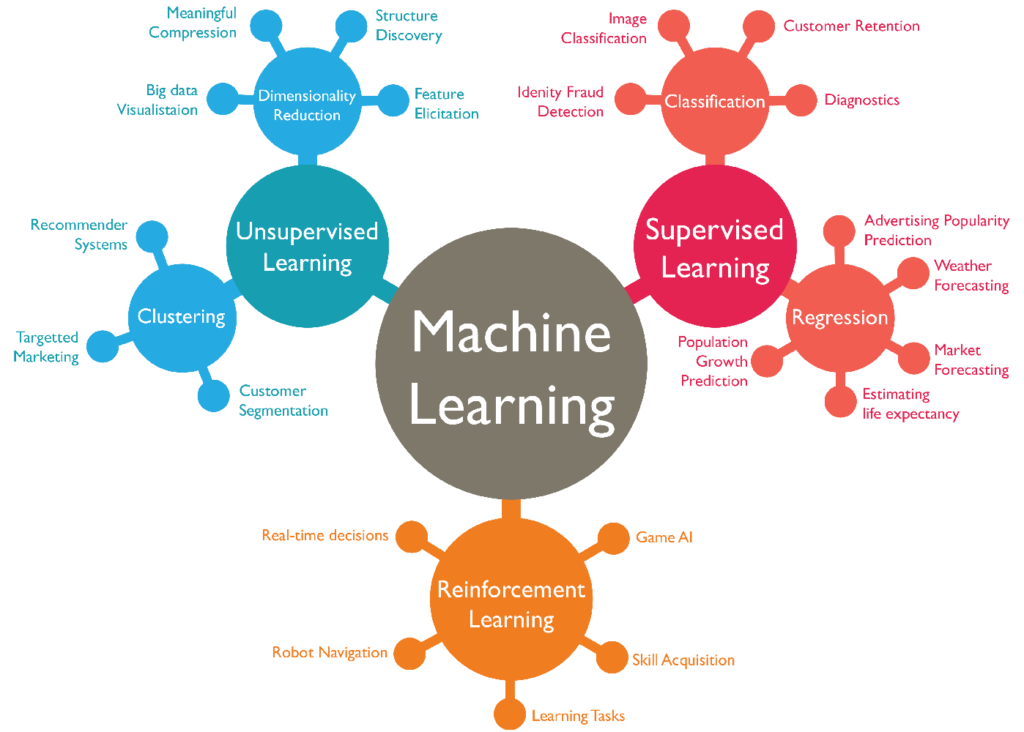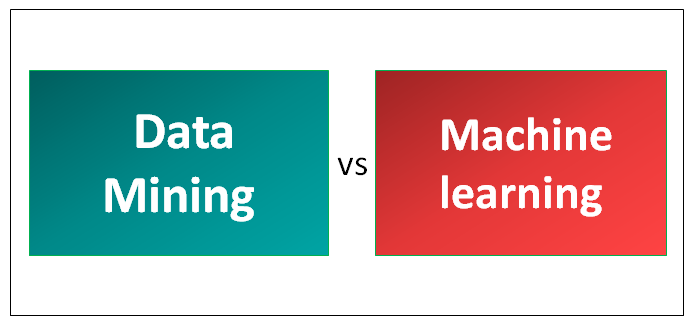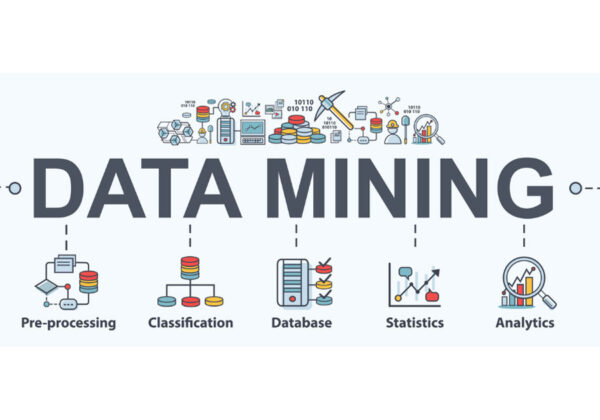Huge leaps in big data and analytics over the past few years mean the average business user is now struggling to master a whole new lexicon of technical terms. This can cause confusion because people are unsure of the difference between terms and methods. In my experience, “data mining” and “machine learning” are good examples.
In this article, I define data mining and machine learning and explain the differences between the two approaches. So if you don’t fully understand the difference, this article is for you.
Table of Contents
What is Data Mining?

Data mining, a subset of business analytics, is the exploration of existing large data sets to mine previously unknown patterns, relationships, and anomalies in the data. It allows us to find new insights that we don’t need to look for — unknown unknowns, if you will.
For example, if a business has a large amount of data on customer churn, it can apply data mining algorithms to discover unknown patterns in the data and identify new associations that might indicate future customer churn. In this way, data mining is often used in retail to discover patterns and trends.
Key Features of Data Mining
Data mining is a simple method of gathering information in which all relevant information goes through some identification process. Here are some key features of data mining:
Automatic discovery: The model mines data by using algorithms to manipulate data collection. Data mining models can be used to mine the data on which they are based.
Actionable information: Data mining can extract meaningful information from massive amounts of data.
Grouping: Data mining looks for natural groups in data. For example, models can identify population groups with incomes in a specific range.
Data mining and statistics: Data mining and statistics have many similarities. In fact, most data mining methods may be placed within a statistical framework.
Data mining and data warehousing: Proper data cleansing and preparation is critical to data mining, and data warehousing can help accomplish these tasks. On the other hand, a data warehouse is useless if it doesn’t have the data you need to solve your problem.
What is Machine learning?

Machine learning is a subset of artificial intelligence (AI). Through machine learning, a computer analyzes large data sets and then “learns” patterns that will help it predict new data sets. Beyond initial programming and possible fine-tuning, computers do not need human interaction to learn data.
Simply put, machine learning is about teaching computers to learn like humans by interpreting information and learning from our successes and failures. As an analytical process, it is particularly useful for predicting outcomes. So Netflix predicts that you might want to watch Ozark Next based on the viewing preferences of other users with similar profiles, which is an example of machine learning. Real-time fraud detection of credit card transactions is another example.
Key Features of Machine Learning
Machine learning has many functions and can be understood by its properties. There are many examples that reflect the characteristics of machine learning in today’s data-rich environment. Here are some key features of machine learning:
Automated data visualization: Machine learning provides multiple techniques for generating rich fragments of data that can be used with both unstructured and structured data. By using user-friendly automated data visualization tools in machine learning, businesses may gain many new insights to improve operational efficiency.
Better customer engagement: Machine learning is critical to helping organizations or businesses initiate more effective customer engagement conversations. Machine learning techniques examine certain words, phrases, sentences and material styles that appeal to specific audiences.
Better analytics: With machine learning, people can process large amounts of data quickly and efficiently. Machine learning can create correct analyses and results by designing fast and efficient algorithms and data-driven models for real-time data analysis.
Improved business intelligence: When machine learning capabilities are combined with data analytics efforts, they can produce extraordinary business intelligence. This has helped several companies make strategic plans.
Major Differences Between Data Mining and Machine Learning

1. Data Mining and Machine learning: Accuracy
The accuracy of data mining depends on the way of data acquisition. Data mining produces accurate results, which are then used for machine learning to improve its performance. Because data mining requires human involvement, it may ignore key associations. However, because machine learning is an automated process, it can produce more accurate results than data mining.
2. Data Mining and machine learning: scope
Data mining is used to discover how various data collection attributes are connected using patterns and data visualization methods. Data mining aims to discover links between two or more attributes in a data set and use this information to predict events or actions. Instead, machine learning is used to predict outcomes, such as price estimates or time length approximations. It automatically learns models as it gains experience. It provides immediate feedback.
3. Data Mining and machine learning: Operational methods
Data mining analyzes the data in a batch format over a specific period of time to create results, rather than continuous analysis. Machine learning, by contrast, uses data mining techniques to update its algorithms and adapt to future inputs. Therefore, data mining can be used as an input source for machine learning. Machine learning algorithms will run continuously and automatically optimize system performance and evaluate when failures are likely. As new data or trends emerge, the computer will absorb those changes without reprogramming or human intervention.
4. Data Mining and machine learning: Use Cases
Currently, there are several data mining applications that can benefit companies. For example, retailers use data mining to discover buying behavior, while mobile businesses use data mining to predict customer churn. Machine learning benefits industries that rely on ARTIFICIAL intelligence, such as Internet streaming services and self-driving cars. Netflix, for example, uses machine learning to pick the next show to binge on, while self-driving cars are built using machine learning.
5. Data mining and machine learning: The amount of data required
Compared with machine learning, data mining can provide results with less data. Machine learning algorithms, on the other hand, require data to be provided in a standard format, which limits the number of accessible methods. To evaluate data using machine learning, data from many sources should be converted from native formats to standard formats that computers can understand. In addition, adequate results require a great deal of data.
6. Data Mining and machine learning: Implementation
The model based on which data mining technology is constructed is the whole content of data mining. The standard process of cross-industry data mining (CRISp-DM) model is established. Data mining methods use databases, data mining engines, and pattern assessment for knowledge discovery. Machine learning, on the other hand, is achieved through the use of machine learning algorithms in artificial intelligence, neural networks, neural fuzzy systems, decision trees and other fields. Machine learning uses neural networks and automated algorithms to predict outcomes.
Key Benefits of Data Mining
Because we live and operate in a data-centric society, it’s vital to get as much benefit as possible. In this complex information age, data mining provides us with a way to solve the challenges and concerns. The benefits of data mining include:
- It helps companies make informed judgments.
- It helps detect credit risk and fraud.
- It allows data scientists to quickly evaluate huge amounts of data.
- Data scientists can use this information to detect fraud, build risk models, and improve product safety.
- It enables data scientists to quickly make automatic predictions about behavior and trends and uncover hidden patterns.
- It helps companies gather reliable information.
- It is a more efficient and cost-effective alternative to other data applications.
Challenges of Data Mining
Data mining presents many challenges. Turning data into an organized piece of information is not easy. Data types, user interaction, cost, and so on can be some of the big challenges that people can face.
Most values in the database may be noisy, incomplete, and inaccurate. It will therefore provide a false representation of the population.
Data is not always available in a single location. Centralizing all the data from different sources into a centralized repository can be a challenge, so there is a high demand for tools that support distributed data mining.
Buying and maintaining powerful software, servers and storage hardware that can handle large amounts of data can be expensive.
Processing large, complex, and unstructured data into a structured format can be time-consuming and costly.
The Main Benefits of Machine Learning
Here are some of the benefits of machine learning. Let’s take a quick look at the benefits of machine learning.
- Machine learning can reduce your workload and time consumption. It lets you write an algorithm and automate the heavy lifting.
- Machine learning has many uses. ML is used in a variety of fields, including medicine, business, finance, and research and technology.
- Machine learning can easily process large amounts of data. It makes analysis easier than other systems can easily handle.
As ML algorithms gain experience, their accuracy and efficiency improve. This enables people to make more informed choices.
The Challenge of Machine Learning
Machine learning experts encountered several problems in developing models from the start. Some of these challenges are described below:
A major challenge for machine learning practitioners is the lack of high-quality data. Unclean and noisy data can lead to wrong algorithms that produce wrong results.
The most critical aspect of the machine learning process is training data to provide correct results. Less training data will lead to incorrect or overly biased predictions.
Machine learning models are very effective at producing the right results, but they take longer. Slow programs, data overloads, and excessive demands all take time to get accurate results.
As the size of your data set grows, the machine learning model you build may become obsolete. What is most acceptable today may go wrong in the future and require further restructuring. Therefore, continuous monitoring and maintenance are required to keep the algorithm running.
Conclusion
This blog provides a comprehensive guide that highlights the differences between data mining and machine learning. It also Outlines the key features, benefits, and challenges each product offers in the marketplace.
Data mining is valuable for companies with data sets ranging from small to large and looking to gain insights from that data. Data mining can help organizations analyze and understand patterns to make better business decisions. For some businesses, however, simply checking past data may not be enough. In addition to detecting data-based patterns, machine learning enables computers to learn and adapt to manage and analyze large amounts of data. Machine learning enables data scientists to teach computers how to automatically extract insights through algorithms. Instead of taking large amounts of data and retrospectively identifying trends and patterns, this technology could help companies continuously extract key information.




